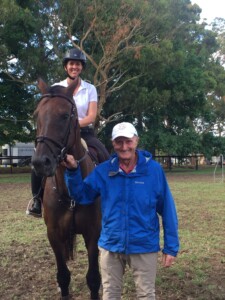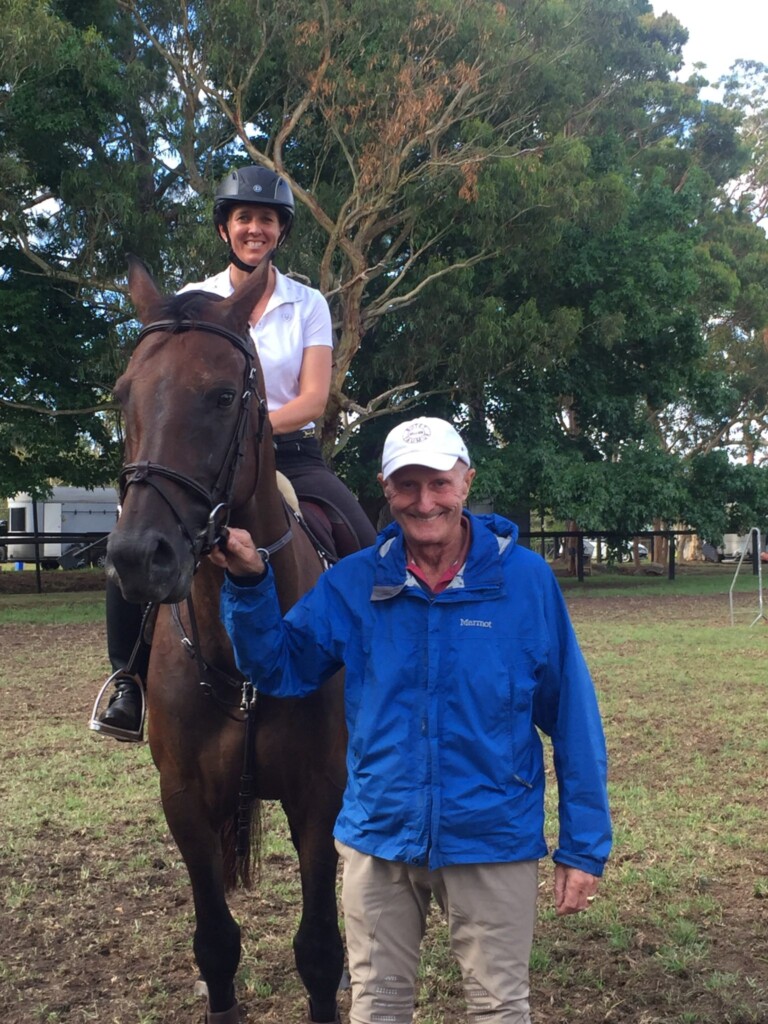There are many stories that I have heard about the infamous Mr George Morris.
I have had the opportunity to attend several clinics as a spectator, watched hours of video footage, read all the books and was born and raised on his system against all the odds (given that I commenced my riding career in the backwaters of regional NSW in the early nineties).
Yet he still managed to surprise me.
And the surprise wasn’t a bad one, it wasn’t when he called me as mad as a cat on a hot tin roof or a desperate housewife or gave me a hard time when I lost my way on a course (all of which were well-deserved mind you and I wore with a badge of honour of being the subject of a George Morrisism!). The surprise came when his real motivation for the strong remarks became so obviously clear and starkly simple.
He doesn’t care about his students names , their horses names, their dreams or potential and certainly not their emotional state at any given moment. Those things are for other people to concern themselves with. He really doesn’t care about individuals much at all neither horses nor humans. Although, having recently read his autobiography, I know he gets enjoyment (and amusement!) on a personal level from both on occasion.
George Morris is passionate about the progress of the riders in his clinics because he truly, wholly and oh so genuinely LOVES his sport. Period. He also, truly, wholly and oh so genuinely LOVES horses. All horses. He might not love your particular horse but he loves and feels so connected to the species that he will, most likely until the day he dies, spend his days trying to help riders bring out the best in their horses. To ride them fairly, sympathetically and systematically in a way that will maximise their potential, whatever that may be.
The system itself is not rocket science, and George himself says he didn’t invent it. It’s a system built on classical riding principles developed throughout the 20th century.
A forward seat to relieve the horse’s back and stay with the horses motion and centre of gravity, a straight line from the hand to the mouth (so yes, if the head goes up, so do the hands), deep heel for lower leg security and shock absorption, educating the horse on the flat to react to lateral aids, lots of shoulder fore, shoulder in, travers, renvers and LOTS of counter canter!
The systematic exercises incorporating these key factors allow both horse and rider to develop control, strength, balance and rhythm, so that when we jump, (keeping in mind that the 5 cornerstones of jumping a fence are pace, track, impulsion, balance and distance) the jump itself should come easily both for us and our horses, no matter what the height.
However, what George does so brilliantly, which is something that I don’t believe you can fully appreciate as a spectator, is he manages to convey, to some extent, his sense of timing. The timing of a rider’s reaction is so fundamental to achieving the sought after result yet is one of the most difficult concepts to teach.
He can see immediately what needs to be done and when to do it to achieve the result that he is after, hence the strength of his vocals. As a coach, his voice is all he has available to use and he uses his clear unequivocal black and white approach the same one that he uses on the horses he rides on his students.
He is tough on his riders, not to degrade or to be mean but to apply the same black and white systematic training approach that he does with the horses. So when we do the right thing we are praised, we are superstars and perfect students but when we get it wrong we something else entirely!
The strength of the correction relates to two things: firstly, the degree of the crime (which I guess is obvious) but secondly, I found that the strength of his correction was also closely related to his attempt to instil a sense of timing in the way we correct our horses. His goal is to teach us to react immediately when we need to and not 1 or 2 seconds later.
And the reality is that if George barks we react immediately, even if our basic human reaction is to feel offended and emotional.
The faster we can with the correct response/correction to our horse, the more likely we are to get the result we are after, which means we are more likely to understand and embrace the George Morris system, which is has been built and developed on a love of both horses and showjumping. And it wouldn’t be an overstatement to say that George’s life’s work is all about leaving a legacy that improves the future for both of those things.
Having spent many, many years following him as an idol, it wasn’t until I rode a clinic with him that it dawned on me where his true genius lies. And it’s not in what he teaches, it’s in the teaching itself.
The concern I have is that in a commercial world which, these days, is so governed by personal ego, political correctness and paying the bills, are there enough George Morrises out there to continue carrying the torch for true horsemanship? I’m not convinced. So I guess that means I ll be trying to get back to as many clinics as I can for as long as he keeps willing to make the trip across the Pacific.
How to survive a clinic with George ¦
Want to do a clinic with George? This is how you will survive it (hopefully!) relatively unscathed ¦
Make an effort:
- Your tack should be simple and immaculate. You should be able to explain every piece of tack used.
- Present your horse like you care, he should be clean, trimmed, fit and well groomed;
- The same goes for you collared shirt, immaculate boots and a belt is a MUST (apparently this is not just for asthetic reasons ¦you never know if you are going to fall off and/or need to catch your horse with a belt!)
- If he corrects you once, he gets pretty frustrated if he has to make the same correction with you 50 times. Which is understandable really
He REALLY doesn’t like:
- Lack of effort
- Tack with clips (eg clip on rings)
- Anything other than heavy stainless steel stirrups
- Bling of any kind, either colour or sparkle! (you might want to rethink the diamante browband and matching saddlecloth, belt and helmet 😉
Consider the following totally essential musts:
- A standard length jumping crop;
- Standard spurs;
- Running martingale
- A belt
Read his books or at the very least have some idea of who Bert de Nemethy and Caprilli were;
Pay attention: that one time you were concentrating on something other than the course plan he was explaining will be the time he asks you to go first;
Commit to his system 150% for the time that you are there with an open mind. You can always go back to your old ways after three days.
Don’t worry too much and remember to enjoy the whole experience. He’s not nearly as intimidating as the legendary tales make him out to be!



